There are more than one hundred and sixty thousand species of moths in the world with new species being added. Many of them remain a mystery with their behaviors and habits being very cryptic.
Have you recently seen an orange moth in your garden or when out exploring and you want to identify it?
We have listed the most common moths in the United States with orange as the primary color. Continue reading below to find out more.
Table of Contents
1. Isabella Tiger Moth
The Isabella Tiger Moth (Pyrrharctia isabella) has yellow to orange-yellow wings with a pointed forewing. The forewing has brown antemedial, post-medial, and median lines. The hind wing is lighter in color, with pink to orange coloration in females.
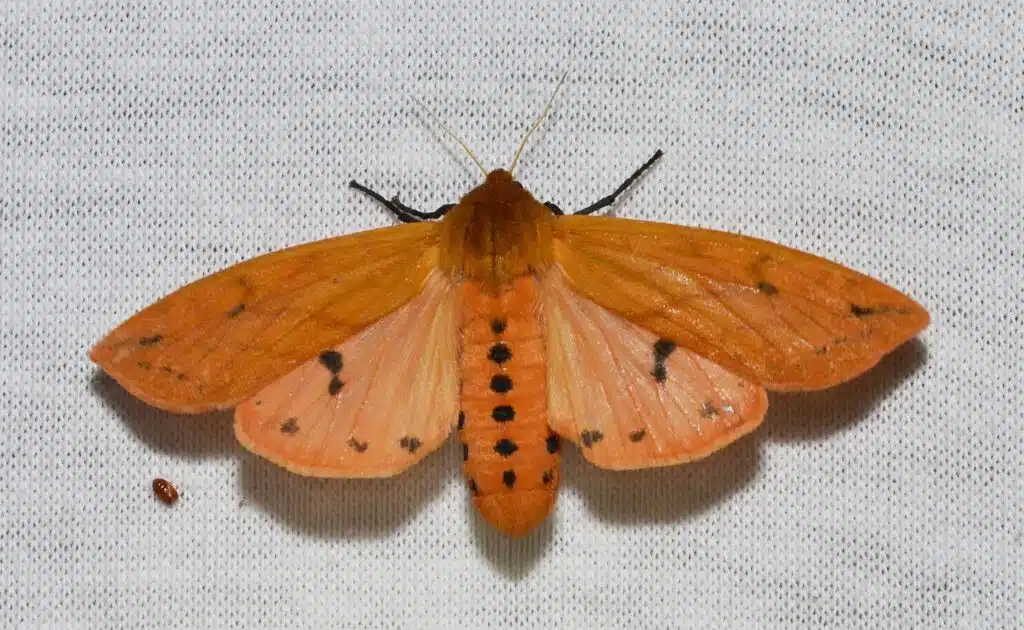
The caterpillars are known as woolly bears. The caterpillar’s color changes with each molt and they become redder with age. This moth grows to 6.5cm in wing span. The caterpillar feeds on birches, clover, elms, sunflowers, asters, corn, and maples.
US and Canadian folklore believe that the amount of black or brown hair on the larva shows bad weather coming. It is also believed that if the brown band is wide, then the winter will be mild, but when the brown band is narrow, they are in for a severe winter.
Some believe that it is the direction in which the caterpillar crawls that will indicate the weather. If the caterpillar crawls to the south, they are escaping cold weather.
2. Regal Moth
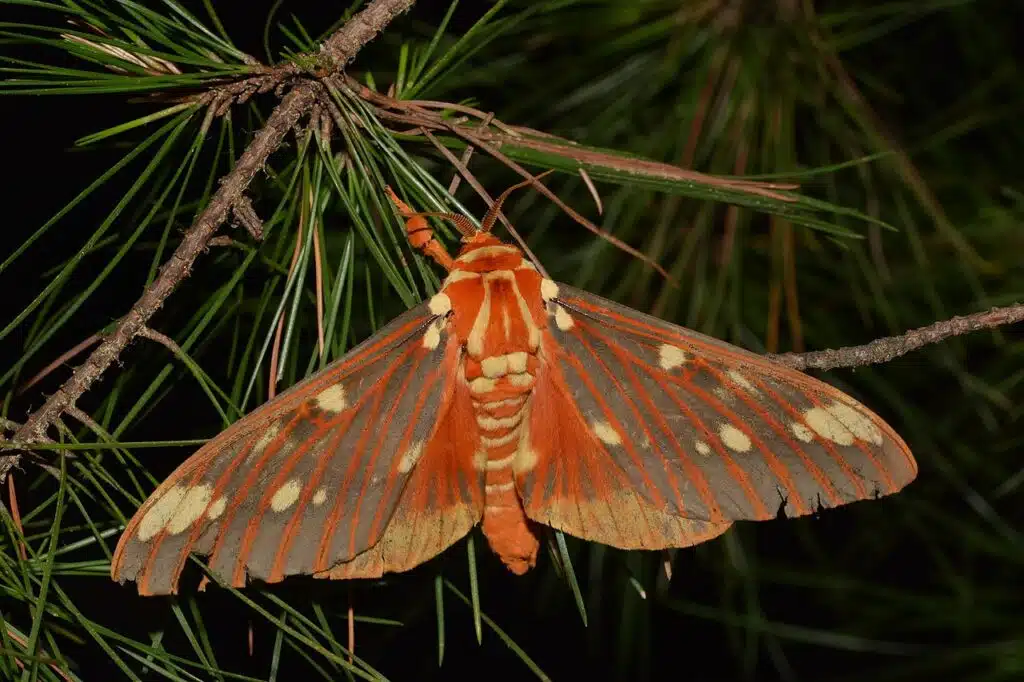
A female Regal Moth (Citheronia regalis) is larger than a male. The forewing is gray with orange veins and yellow spots. The hind wing is orange with yellow at the inner margin and costa. This is a large moth that can grow to 16cm in wing span.
The adult moth will come out in the late evening and they mate the following evening. The female will deposit her eggs in groups of three on the host plant’s leaves. Eggs hatch within ten days and the caterpillars feed alone. They are commonly seen flying from May to September.
The caterpillar hosts include pecan, butternut, hickories, cultivated cotton, and sumacs. The adult does not feed. They are common in deciduous woods in New York, Michigan, Kansas, central Florida, and Texas.
3. Orange-tipped Oakworm Moth
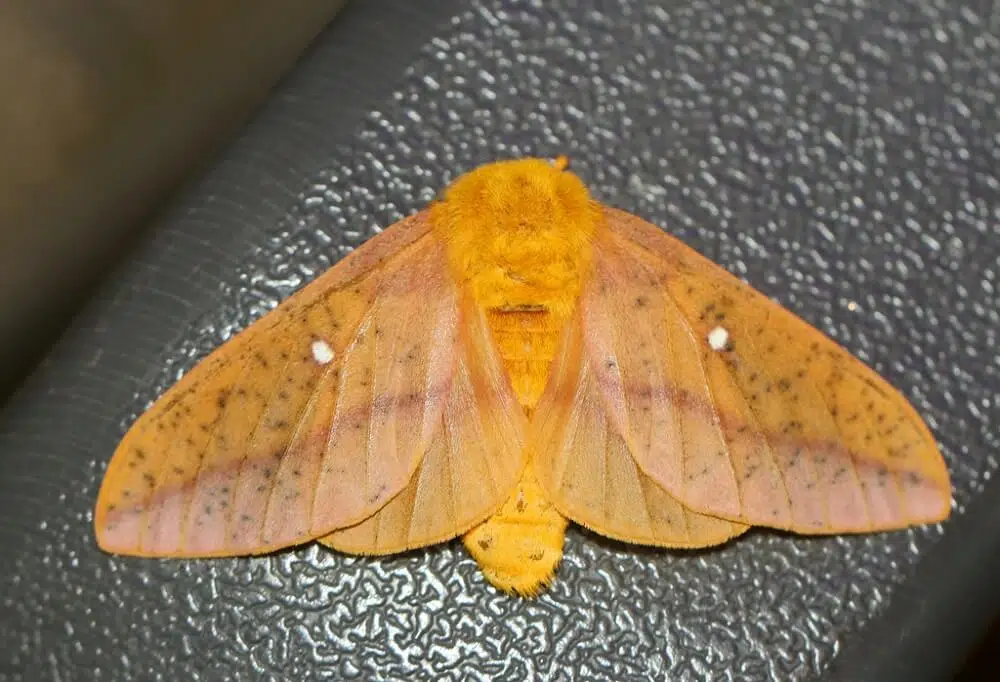
The female Orange-tipped Oakworm Moth (Anisota senatoria) is double the size of the male. The female is yellow-brown to yellow-orange with a white spot on the forewing, along with scattered dark specks. The male is red-orange to brown-orange with a narrow forewing. and a small white spot with a small translucent patch.
The moth can grow to 5cm in wing span with the adults flying during the daytime. They are commonly observed in June and July. As caterpillars, they feed on various oaks, while the adults do not feed.
You will encounter this orange moth in deciduous forests in Southern Maine, the Great Lakes, central Minnesota, central Georgia, central Alabama, Mississippi, east Texas, and Louisiana. This moth species have a large population that is enough to cause the defoliation of oaks in the areas where they are in abundance.
4. Pink-striped Oakworm Moth
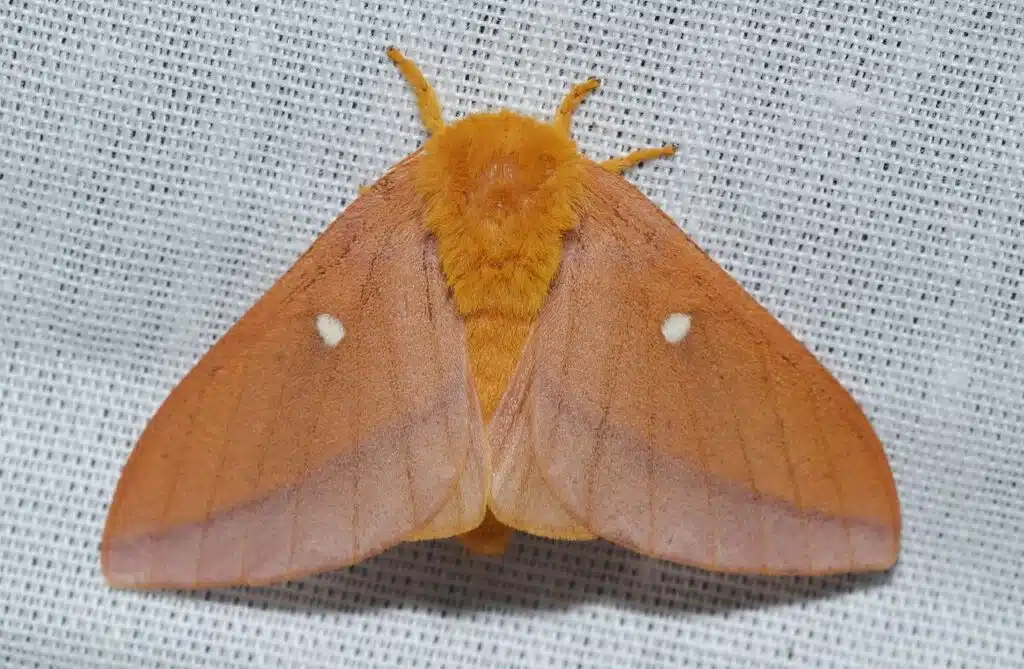
As with most moths, the female Pink-striped Oakworm Moth (Anisota virginiensis) is larger than the male. The female is orange with purple margins on the wings. There are black specs, which may be absent. The male is dark brown with red on the hind wing and a large translucent spot on the forewing. Both the male and female have a small white spot on the forewing.
This moth can grow to 6.6cm in wing span. They fly during the day, mating in the mornings. The female will lay eggs in groups under oak leaves after dusk. Once hatched, the caterpillars feed together in groups.
This moth flies in June and July in the north and May to September in the south. They are often encountered throughout the year in Florida. You can encounter these moths in Nova Scotia, the Great Lakes, Minnesota, Florida, east Texas, and the Gulf Coast in deciduous woodlands, tree-lined city streets, and suburbs.
5. Sparganothis Fruitworm Moth
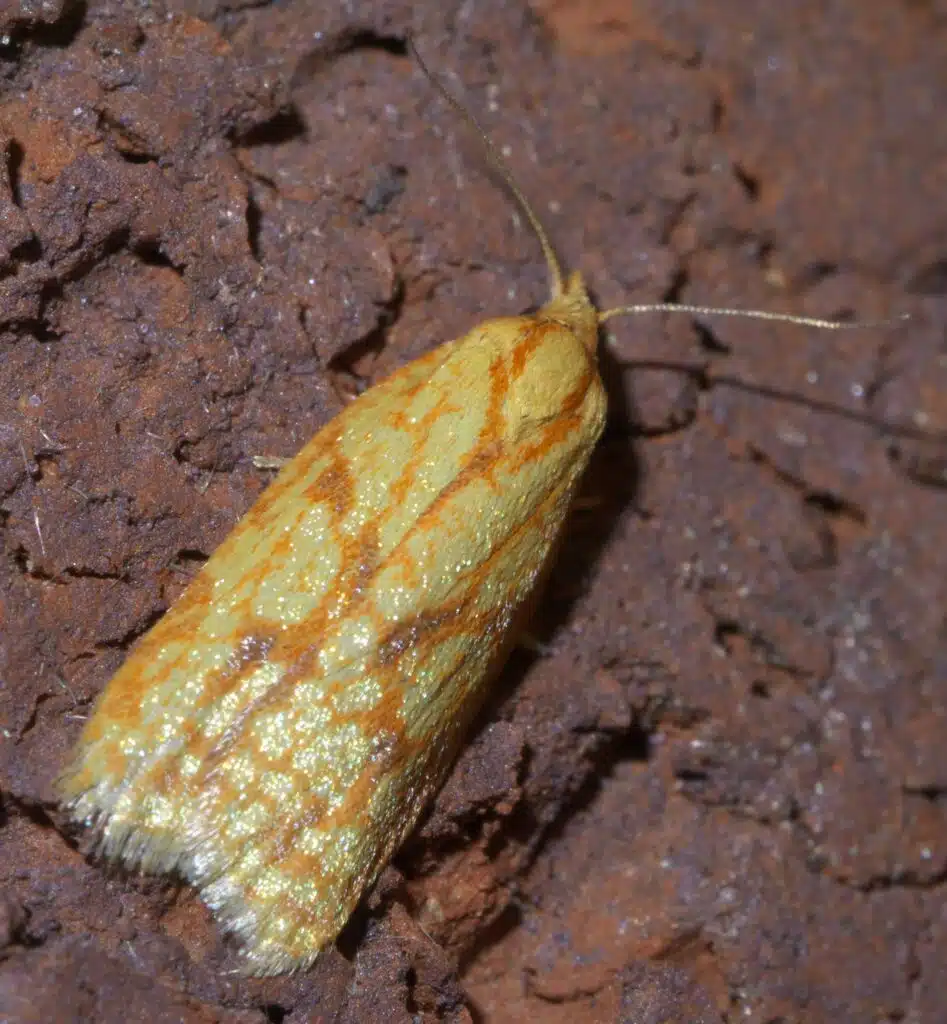
The Sparganothis Fruitworm Moth (Sparganothis sulfureana) is also referred to as the blueberry leaf-roller. They belong to the Tortricidae family and are common in eastern North America and Cuba. This is a small moth and grows to 2cm in wing span.
You can identify its yellow forewings with red-brown net markings. The hind wings are gray or dirty white. They are common from May to October. As caterpillars, they feed on woody plants, which include cranberry and corn.
6. Orange-headed Epicallima Moth
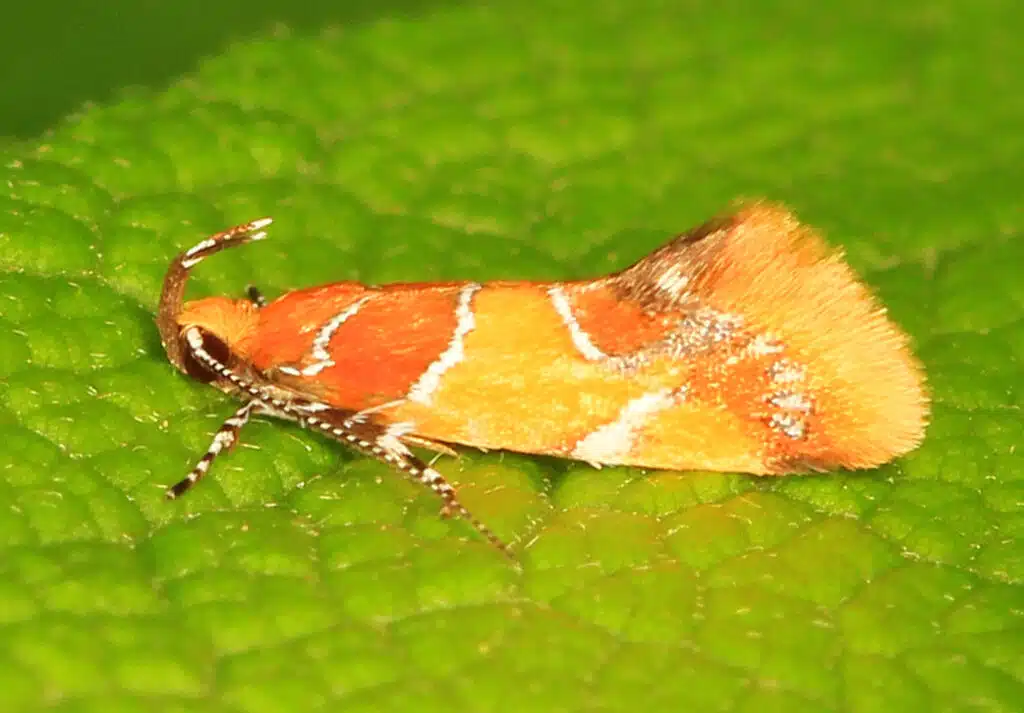
This small moth (Epicallima argenticinctella) grows to 2cm in wing span and has black and white scales on both antennae. It has an orange forewing with a fringe, white lines, and black edges. They are common from May to Early September and are sometimes seen as early as March in Texas.
As caterpillars, they feed on corn plants and can be found under the bark of elm trees. You are likely to encounter this moth from Nova Scotia to Southern Carolina and Texas to Kansas.
This moth belongs to the Oecophoridae family and is seen in deciduous forests.
7. Suzuki’s Promalactis Moth
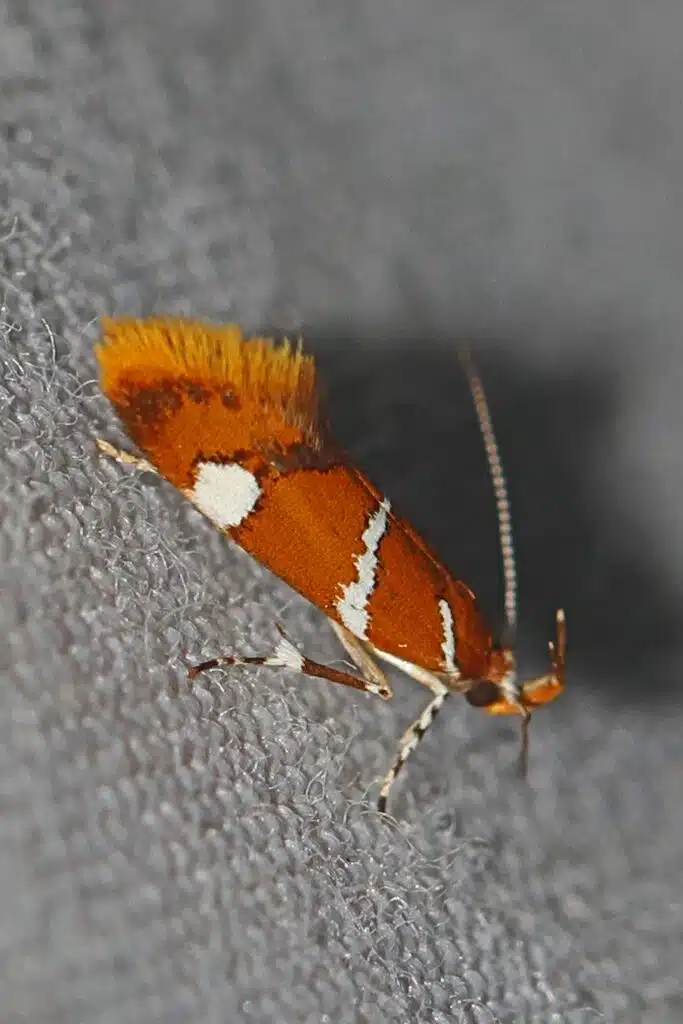
This moth (Promalactis suzukiella) is native to Japan, Taiwan, and Korea and was introduced to the United States. It was originally only recorded in the mid-Atlantic states, but has extended its range and can now be found in Texas and Mississippi.
The Suzuki’s Promalactis Moth can grow to 7cvm in wing span and they fly from March to September. The larvae feed under rotting log bark. Today you can find this moth in New York, Maryland, Pennsylvania, New Jersey, and Virginia.
8. Spiny Oakworm Moth
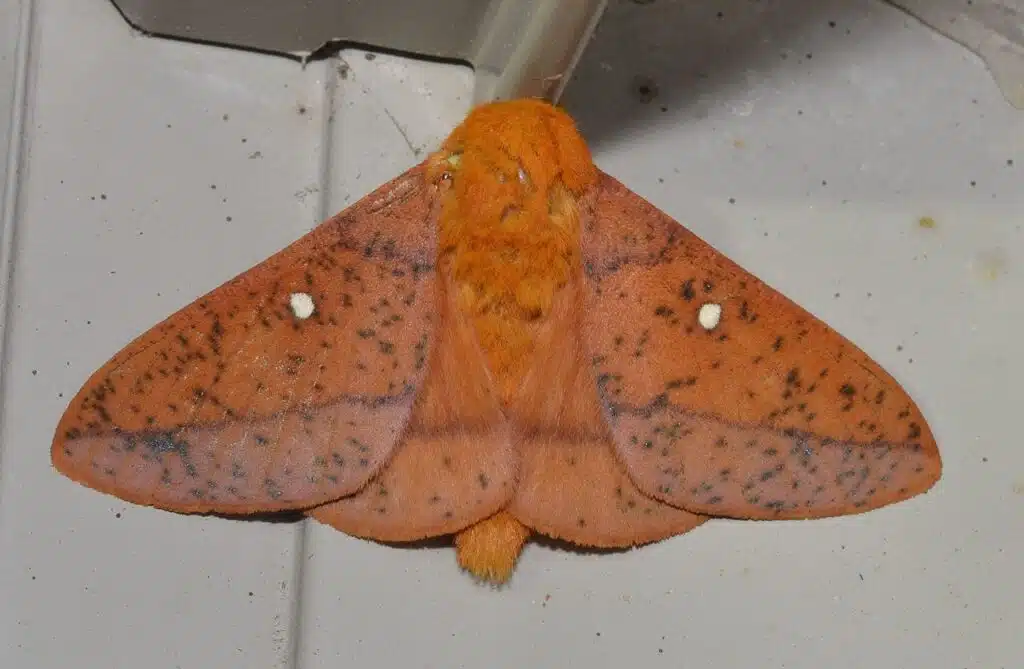
The female is larger than the male and can grow to 7cm in wing span. This moth (Anisota stigma) has a red-orange wing with small black specs and a faint post-median line. The forewing has a white cell spot. The male is redder than the female.
The female lays her eggs in clutches of twenty, which take around two weeks to hatch. The young caterpillars feed together at first and then start feeding on their own. They are seen during June and July in the north, July to August in the south, and in August and September in Texas.
Their preferred habitat is deciduous woods in Southeastern Canada, New England, Minnesota, Florida, central Texas, and the Gulf Coast.
9. Orange Wing
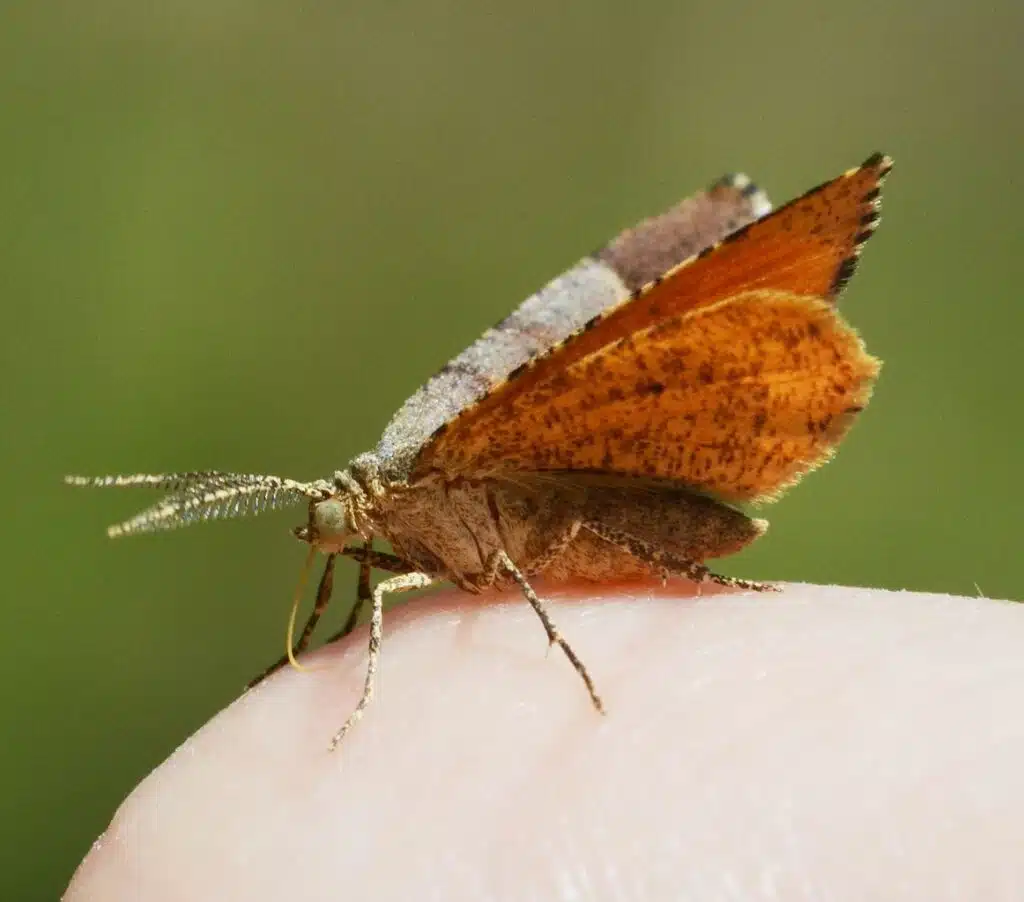
The Orange Wing Moth (Mellilla xanthometata) is the only geometer moth with bright orange hind wings. The forewing is gray to brown with straight lines and a black spot. They can grow to 2.1cm in wing span and fly during the day and night.
You will see this moth from April to October when the caterpillar feeds on Locust trees. They are common in South Carolina, New Jersey, Texas, and Nebraska.
10. Southern Pink-striped Oakworm Moth
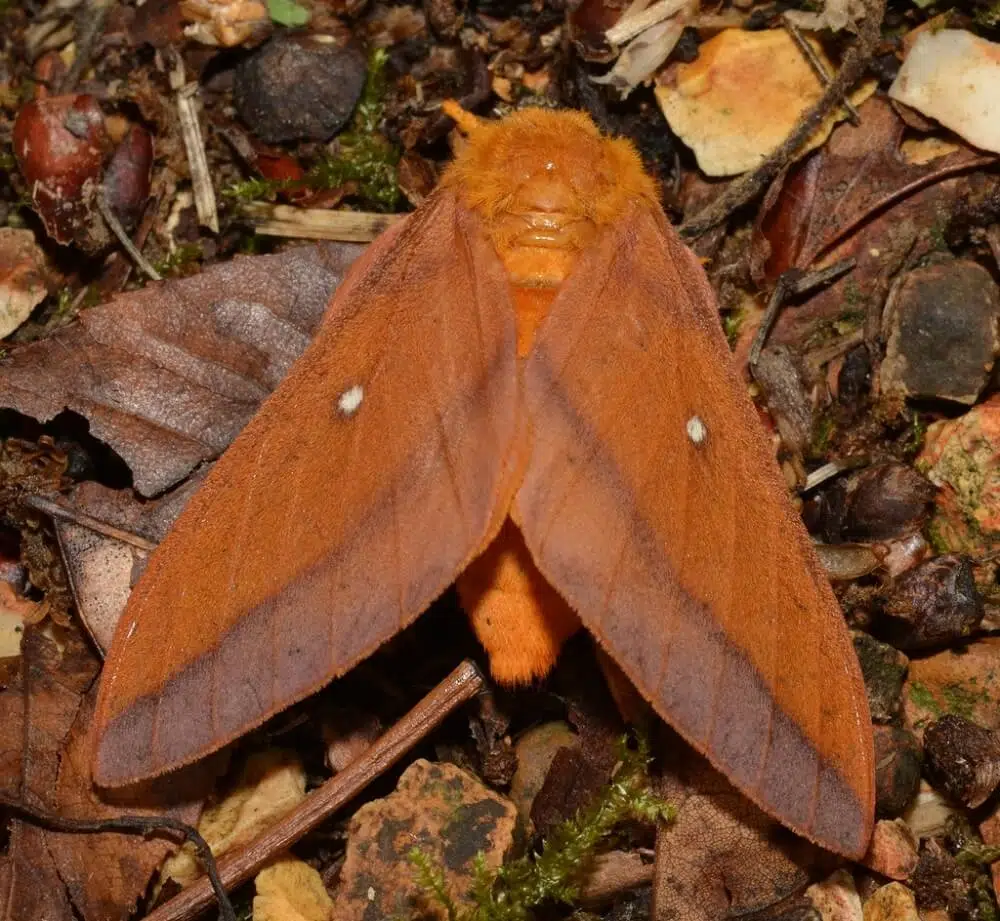
The female is orange with purple margins on the wings. The female is larger than the male. Males are dark brown with red on the hind wing and a large translucent white spot on the forewing. Both males and females have a small white cell spot on the forewing.
This moth (Anisota pellucida) can grow to 6.6cm in wing span and as adults, they fly during the day, mating in the morning. In the north, they are common in June and July, in the south, they are seen from May to September, and they are common throughout the year in Florida.
The caterpillar feeds on numerous oaks, while adults do not feed. They are seen in tree-lined city streets, deciduous woodlands, and suburbs. They are common in east Texas, Minnesota, central Florida, Nova Scotia, the Great Lakes, and the Gulf Coast.
It’s not uncommon to see the female southern pink-striped oakworm moth at night, as the female is attracted to artificial lights. The males are very agile fliers and are often mistaken as a bee at first. As caterpillars, they are brown-green with white specs and long pink stripes from the head to the rear. They have segments that have short black spikes.
11. Maple Spanworm Moth
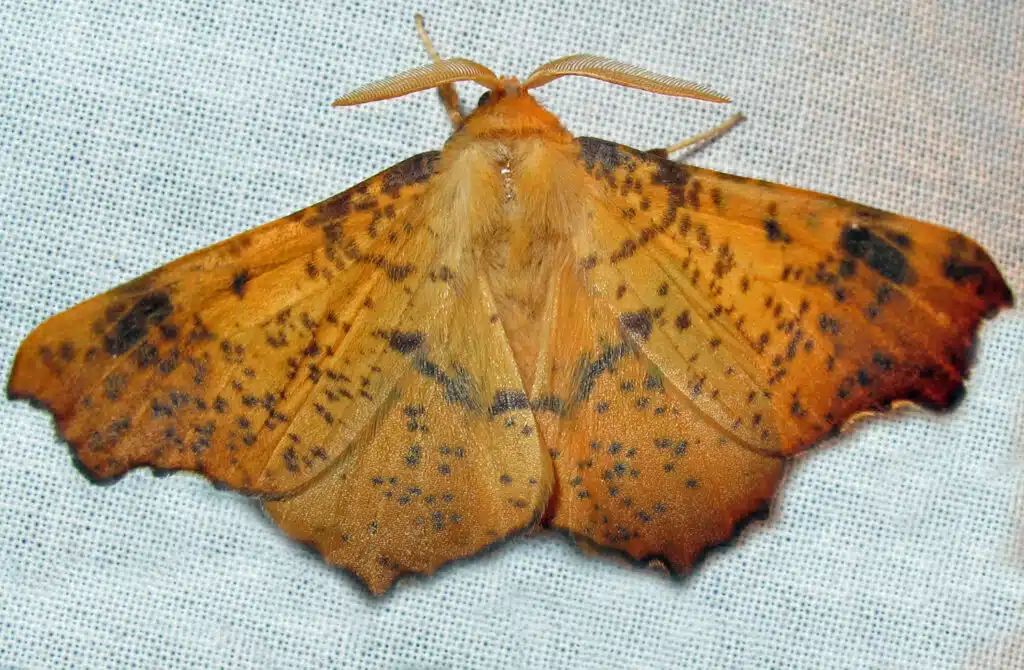
The Maple Spanworm Moth (Ennomos magnaria) is also known as the notched-wing moth or notch-wing moth, belonging to the Geometridae family. It was first described in 1858 and is common in southern Canada and the northern United States.
This moth can grow to 6cm in wing span with adults resembling a fall leaf. There are deep scallops on the bright orange-yellow wings. There are also spots of brown and red-brown on the outer margin of the wings.
Adults fly from July to November. The larvae feed on the leaves of Acer, Populus, Ulmus, and Tilia species. The larvae mimic twigs and are brown, gray, or green with white spots. Larvae are common from May to August.
You will encounter this moth in mixed and deciduous woodlands and they are attracted to artificial light at night.
12. Herald Moth
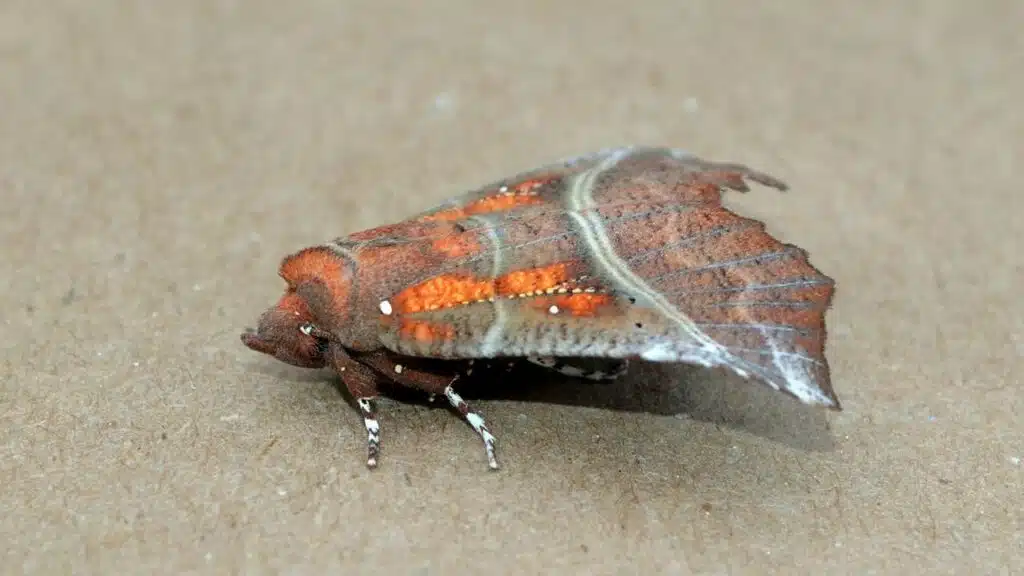
This moth (Scoliopteryx libatrix) belongs to the Erebidae family and was first described in 1758. It is common in the Palaearctic and Nearctic. They grow to 4.4cm in wing span. The wings are angled in the middle of the outer edge and concave between the angle and acute at the apex.
This moth has a gray forewing with white veins. The irregularly shaped median line is orange to red with dark edges and a white spot. The hind wing is lighter at the base. As larvae, they are white-yellow.
You are likely to encounter the Herald moth from June to November. They hibernate during winter in cool structures, which include barns, caves, and cellars. They prefer woodland parks and gardens. They are often seen resting with a wing pattern that looks like a dead leaf.
As caterpillars, they are bright green with thin yellow lines that run across the body segments. The caterpillars feed on willow, popular, and aspen. As adults, they feed on ripe blackberries, raspberries, and ivy blossoms.
13. Bicolored Pyrausta Moth
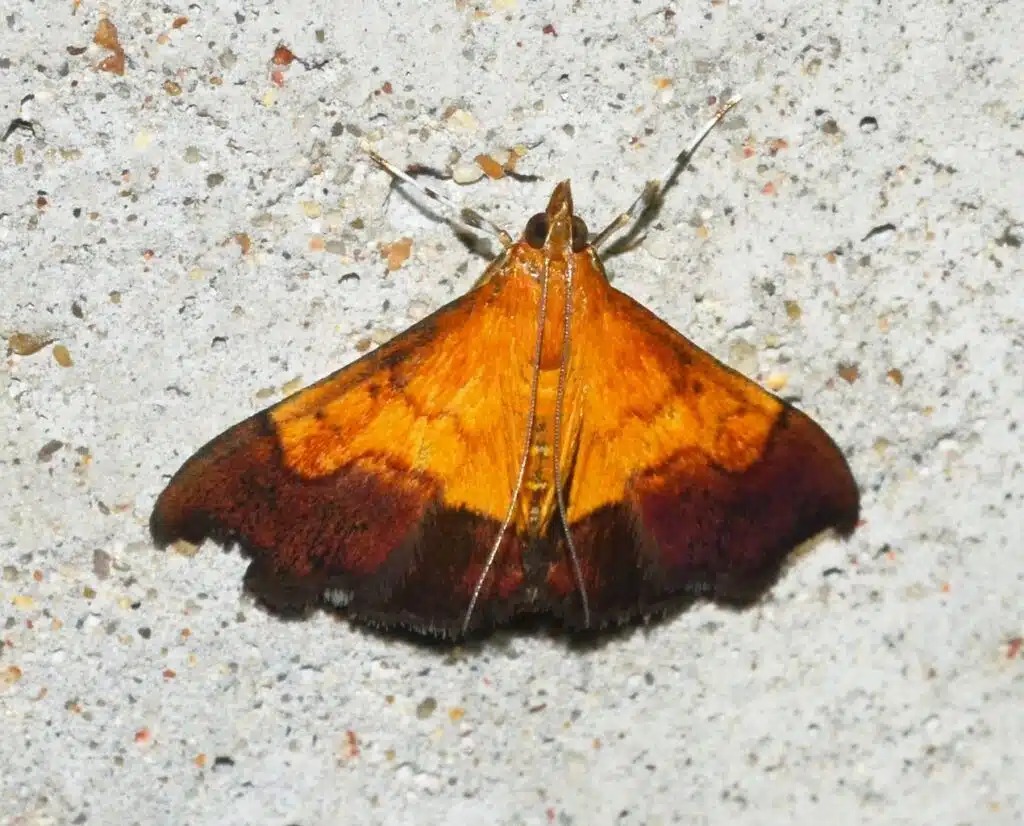
This moth (Pyrausta bicoloralis) belongs to the Crambidae family and was first described in 1854. It can be found in North America and Nova Scotia. The Bicolored Pyrausta Moth can grow to 1.9cm in wing span.
The adults are yellow and purple and fly from June to September. The golden-yellow or orange coloration covers the majority of the wings with a dark purple band at the bottom part. The two colors are separated by an irregular line with a white or gray fridge.
They have large eyes that bulge from the head. This moth remains a mystery and what the caterpillars feed on is still unknown.
14. Orange Beggar
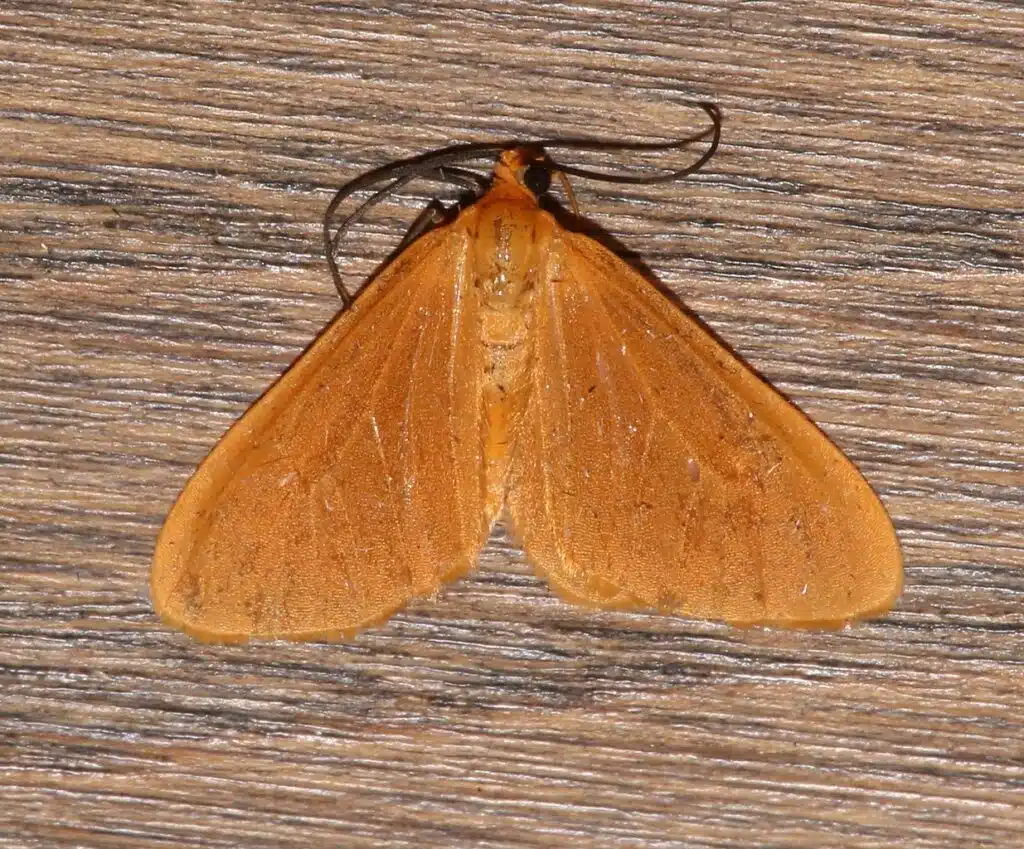
There is very little information on the Orange Beggar moth (Eubaphe unicolor), which belongs to the Geometridae family. It is found in North and South America. The Orange Beggar is completely orange with black antennae and legs. They do vary from dark to light orange, depending on their location.
15. Black-and-yellow Lichen Moth
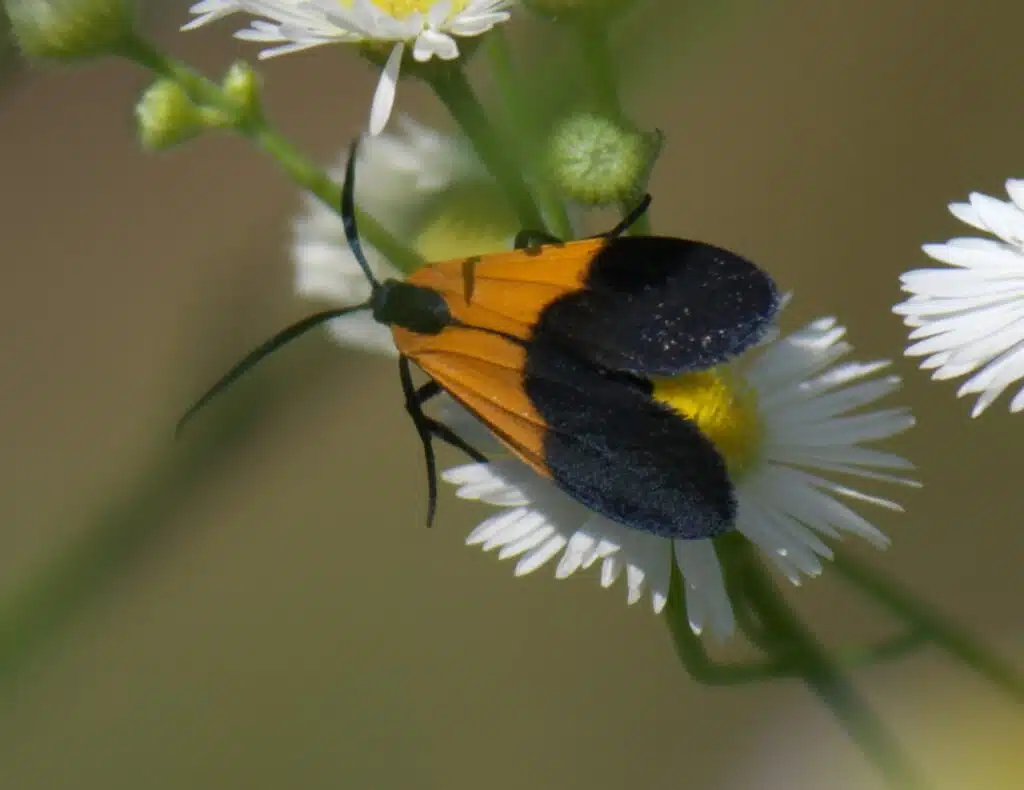
The Black-and-yellow Lichen Moth (Lycomorpha pholus) has a blue back with the base of the wings being an orange-yellow. They grow to 3.2cm in wing span and fly during the day. You are likely to see them on flowers during the daylight hours from July to September.
Their range is from Nova Scotia to North Carolina, South Dakota, and Texas. This moth belongs to the Erebidae family and is often seen in short-grass prairies. As caterpillars, they feed on lichen, resembling the host plant.
16. Southern Ugly-nest Caterpillar Moth
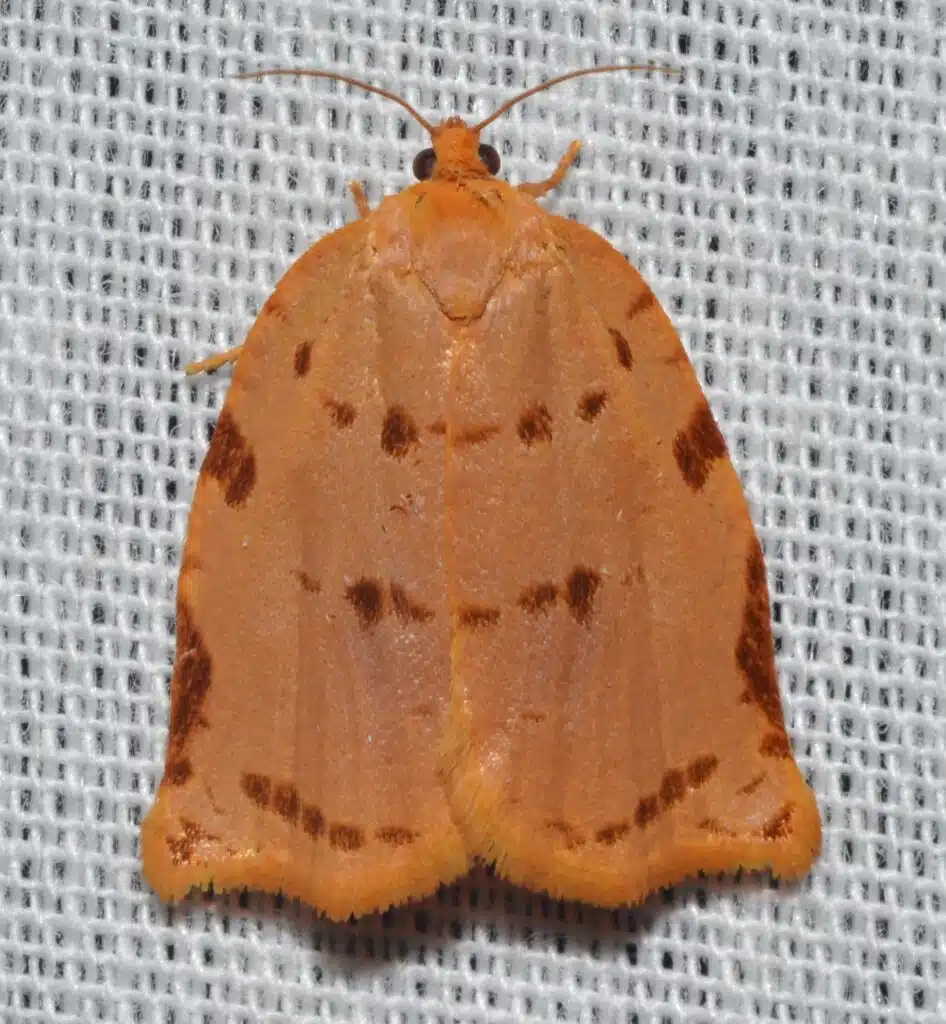
The Southern Ugly-nest Caterpillar Moth (Archips rileyana) belongs to the Tortricidae family and is common in North America. It is found in Alabama, Georgia, Mississippi, North Carolina, Texas, West Virginia, Florida, Maine, Missouri, Ohio, Texas, and Virginia.
This moth can grow to 2.6cm in wing span and is often encountered from March to July. The caterpillars feed on Aesculus, Vernonia, Prunus, Juglans, and Cornus species.
17. Honey Locust Moth
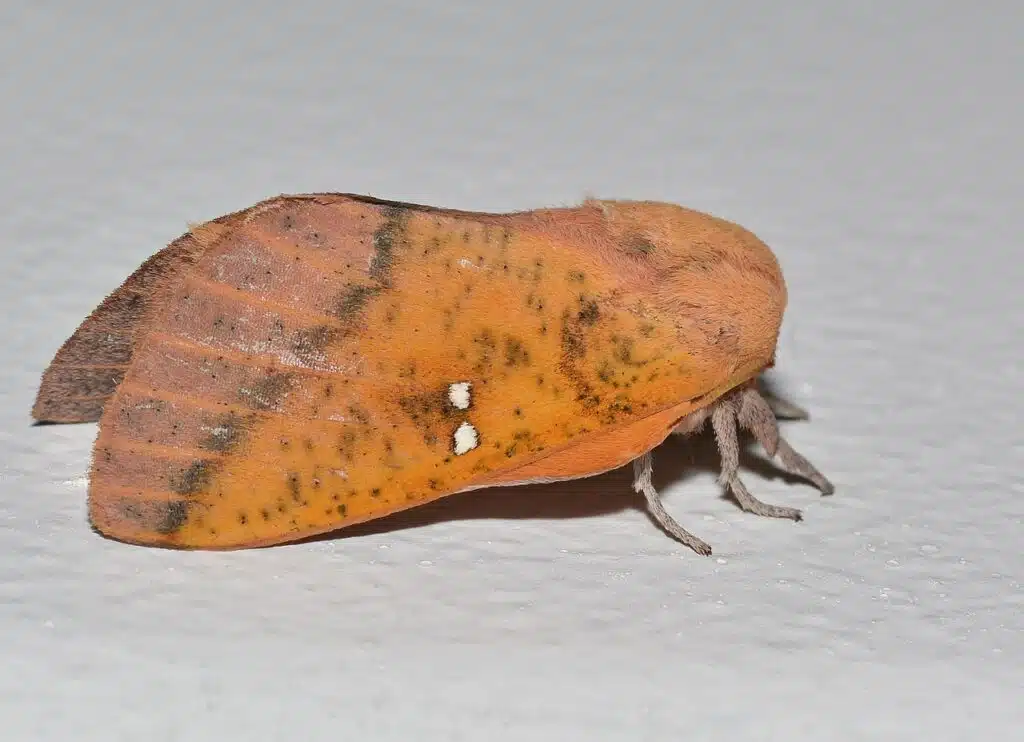
The Honey Locust Moth (Syssphinx bicolor) varies based on season and the individual insect. The female is larger than the male with red-brown to red-orange wings. The forewing has a post-median line, which bends towards the wing base. There are also up to two white cell spots. The hind wing does not have a sub-median line. Both wings have scattered black specs.
This moth can grow to 6.7cm in wing span. They are nocturnal and emerge in the evening, mating late at night. Females lay their eggs as singles or pairs on the leaves of host plants. The eggs hatch within five days.
Their life cycle is complete within six weeks with adult caterpillars pupating in underground chambers. They are common from May to June and July to August in the extreme north, and April to September in the remainder of the range.
Caterpillars host on honey locusts and Kentucky coffee trees, but the adults do not feed. They are common in deciduous woodlands in New Jersey, Ontario, Wisconsin, South Carolina, Georgia, Alabama, Mississippi, Texas, Louisiana, Rio Grande Valley, and Mexico.
18. Juniper Geometer Moth
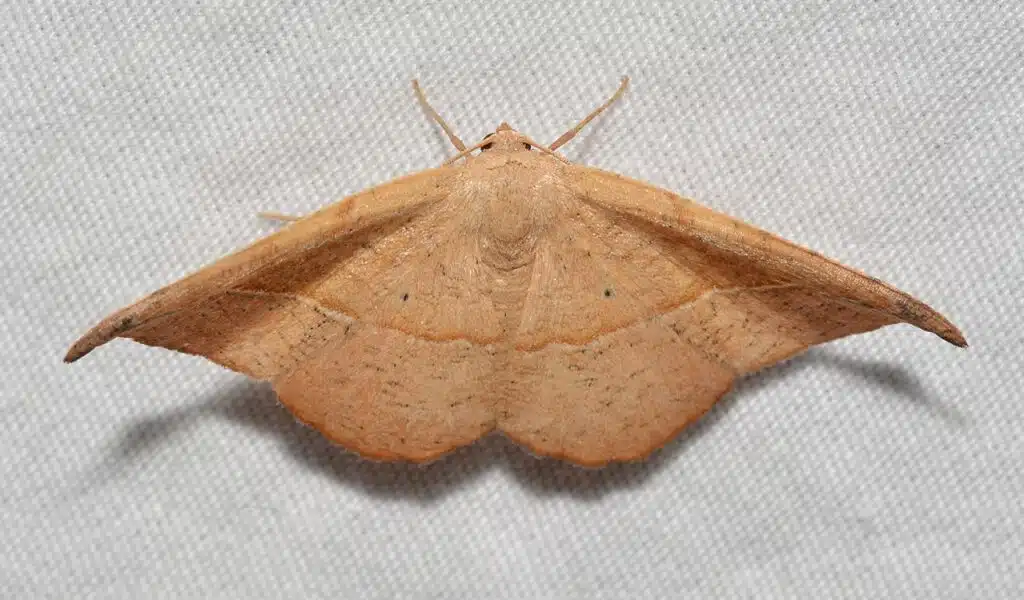
The Juniper Geometer Moth (Patalene olyzonaria) belongs to the Geometridae family and can be found from New Hampshire to Quebec, Florida, Texas, and Wisconsin. They grow to 2.5cm in wing span.
The adult flies from April to November and has up to three generations each year. The caterpillars feed on Juniperus species.
19. Ruddy Holomelina
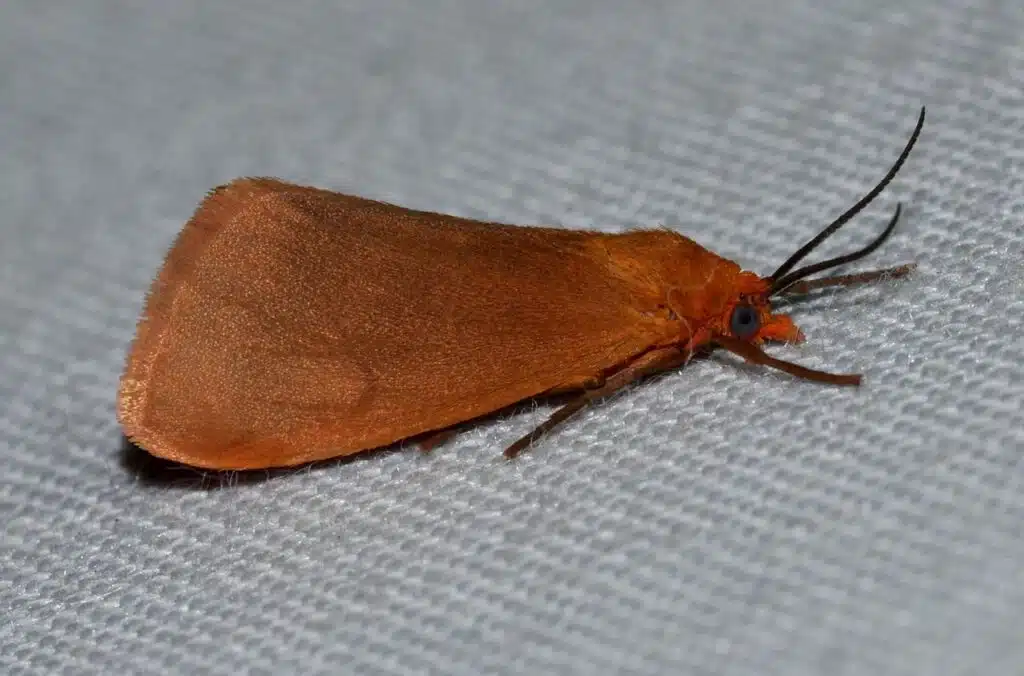
The male Ruddy Holomelina (Virbia rubicundaria) can grow to 8.9cm in wing span, while females grow to 8.7cm in wing span. This moths head has orange hues. The segments are flesh in color. The fore wings have light orange and the hind wings have brown spots and black markings.
They are common in Florida, Georgia, the Gulf Coast, and eastern Texas. They fly throughout the year with caterpillars feeding on dandelion species and Lactuca floridana.
20. Showy Holomelina
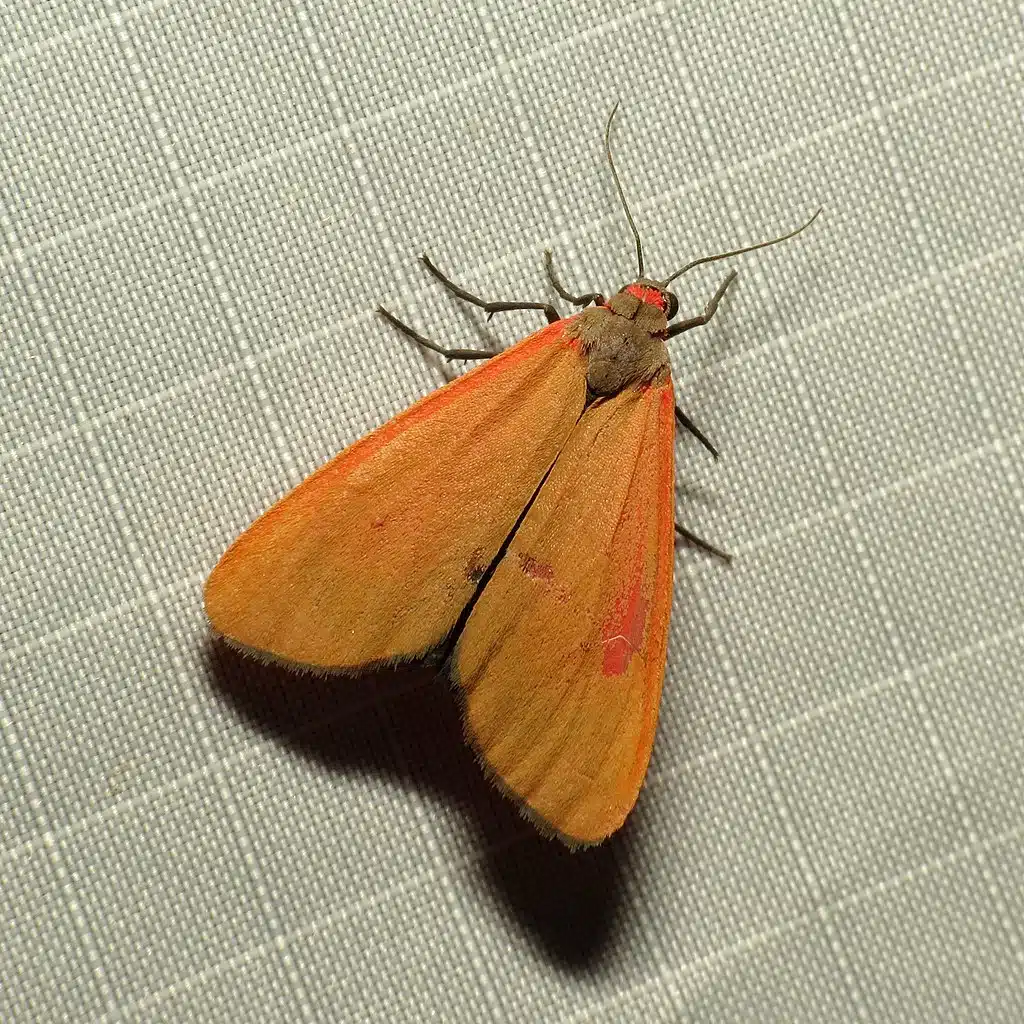
The Showy Holomelina (Virbia ostenta) belongs to the Erebidae family and was first described in 1881. This moth can be found in mountain ranges in New Mexico, Mexico, and Arizona.
This is a small moth with males growing to 1.7cm in wing span and females growing to 1.8cm in wing span. The male is clay in color with a salmon band and dark hind wings with a geranium-pink pattern. The female has brown forewings with a peach to red band. Her hind wing is fuscous with a geranium-pink pattern.
21. Oslar’s Oakworm Moth
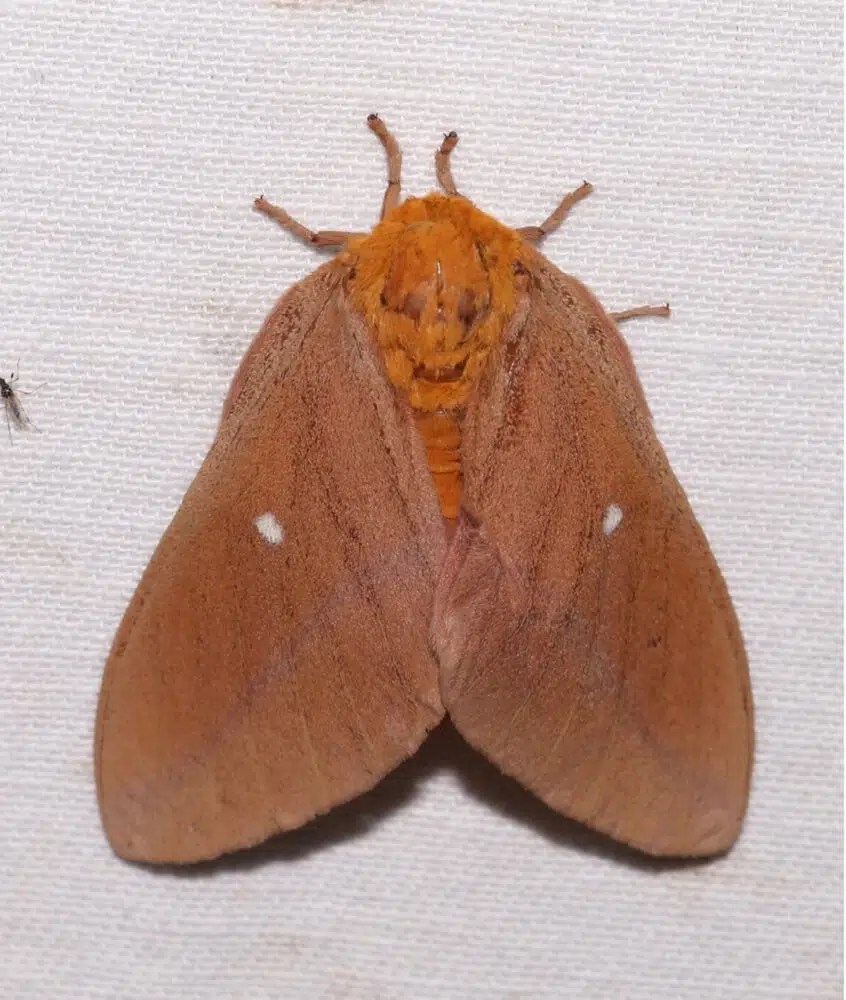
The female Oslar’s Oakworm Moth (Anisota oslari) is larger than the male. The female is brown-yellow with a white cell spot on the forewing. The male is red-brown with a darker hind wing and a white cell spot on his forewing. They can grow to 8.6cm in wing span.
This moth is active during the day, mating in the morning. The female will lay her eggs in clusters on oak leaves in the evening. The young caterpillars feed together and become solitary as they age. The fully-grown caterpillars pupate and spend their winter in underground chambers.
As caterpillars, they feed on various oak species, which include scrub live oak and Mexican blue oak. They are common in oak scrub in Colorado, New Mexico, Arizona, east Texas, and Mexico.
22. Painted Lichen Moth
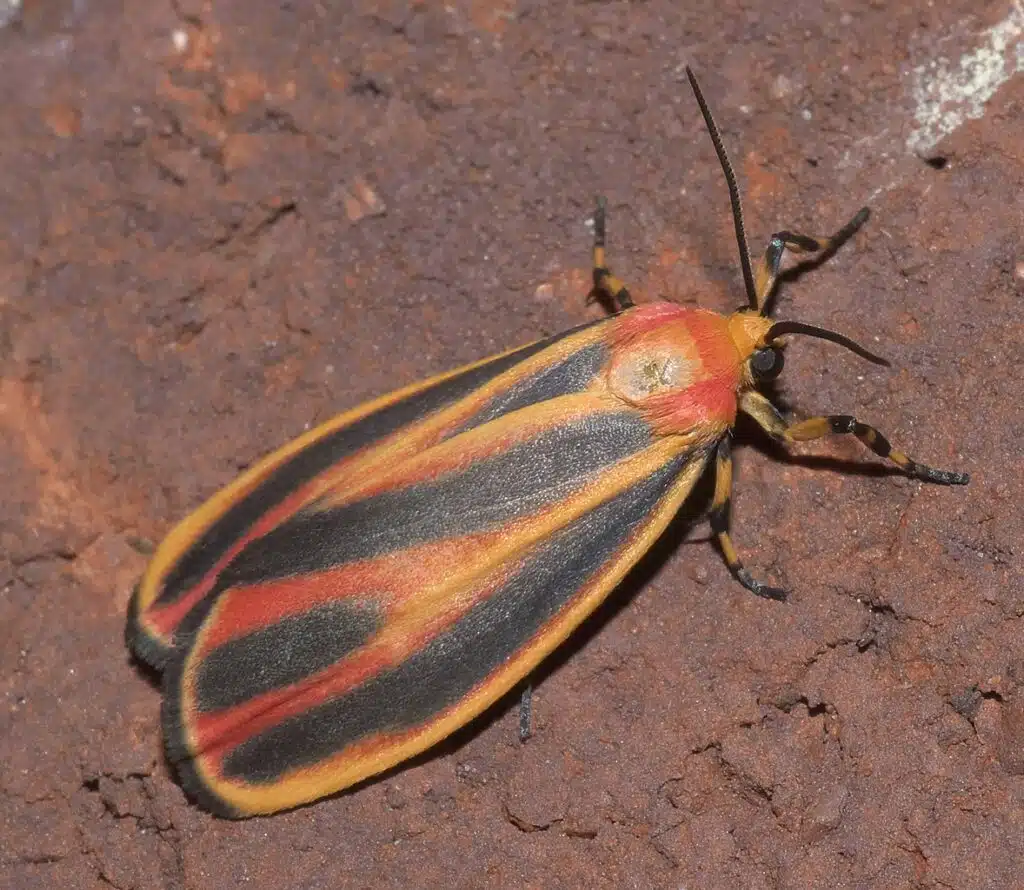
The Painted Lichen Moth (Hypoprepia fucosa) can grow to 3.5cm in wing span and belongs to the Erebidae family. This moth was first described in 1831 and is common in the United States and southern Canada.
As adults, they fly from May to August in the north and throughout the year in Florida. The larvae feed on algae, lichen, and tree moss.